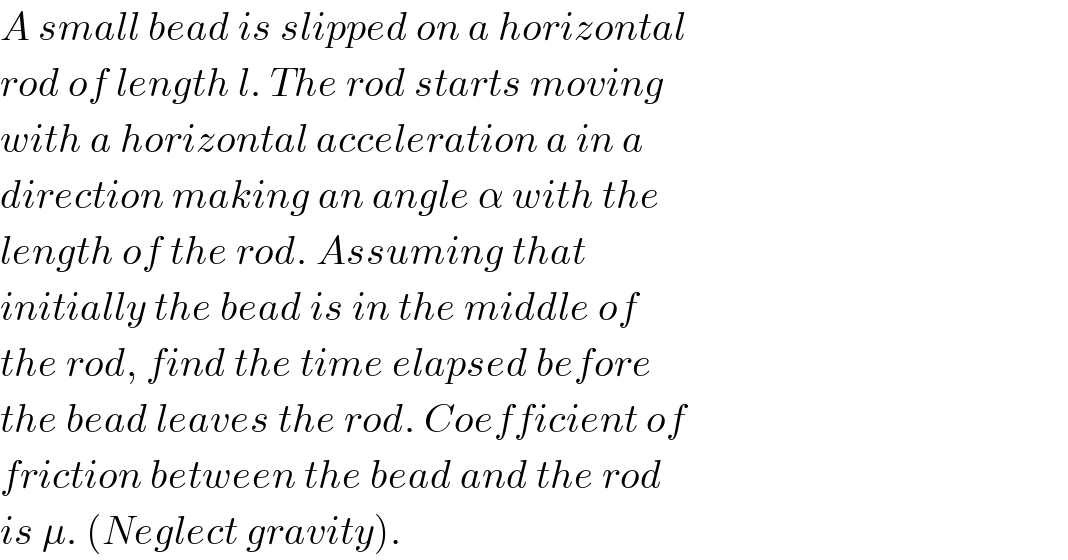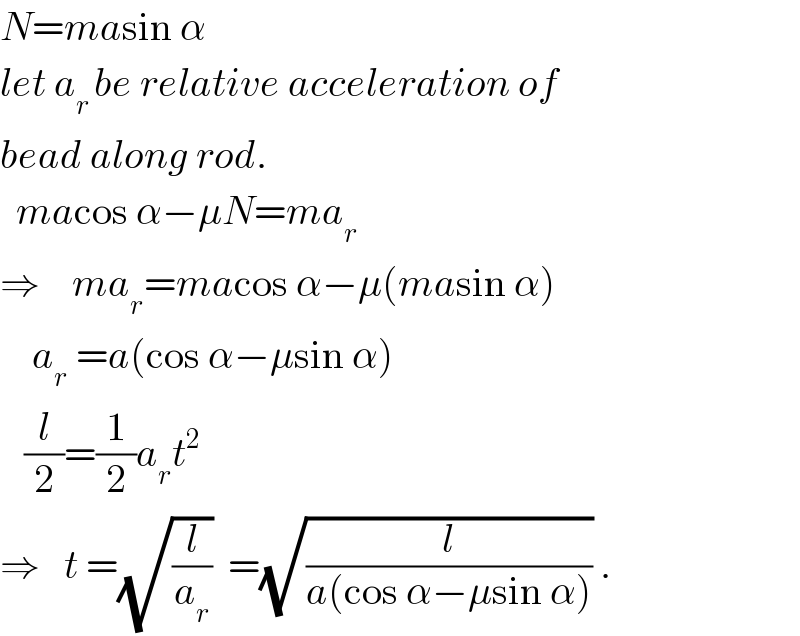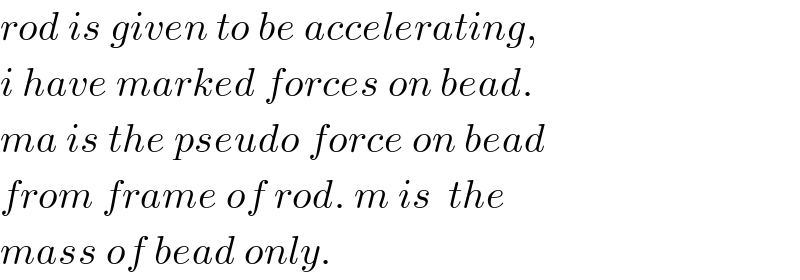
Question Number 20764 by Tinkutara last updated on 02/Sep/17

$${A}\:{small}\:{bead}\:{is}\:{slipped}\:{on}\:{a}\:{horizontal} \\ $$$${rod}\:{of}\:{length}\:{l}.\:{The}\:{rod}\:{starts}\:{moving} \\ $$$${with}\:{a}\:{horizontal}\:{acceleration}\:{a}\:{in}\:{a} \\ $$$${direction}\:{making}\:{an}\:{angle}\:\alpha\:{with}\:{the} \\ $$$${length}\:{of}\:{the}\:{rod}.\:{Assuming}\:{that} \\ $$$${initially}\:{the}\:{bead}\:{is}\:{in}\:{the}\:{middle}\:{of} \\ $$$${the}\:{rod},\:{find}\:{the}\:{time}\:{elapsed}\:{before} \\ $$$${the}\:{bead}\:{leaves}\:{the}\:{rod}.\:{Coefficient}\:{of} \\ $$$${friction}\:{between}\:{the}\:{bead}\:{and}\:{the}\:{rod} \\ $$$${is}\:\mu.\:\left({Neglect}\:{gravity}\right). \\ $$
Answered by ajfour last updated on 02/Sep/17

Commented by ajfour last updated on 02/Sep/17

$${N}={ma}\mathrm{sin}\:\alpha \\ $$$${let}\:{a}_{{r}\:} {be}\:{relative}\:{acceleration}\:{of} \\ $$$${bead}\:{along}\:{rod}. \\ $$$$\:\:{ma}\mathrm{cos}\:\alpha−\mu{N}={ma}_{{r}} \\ $$$$\Rightarrow\:\:\:\:{ma}_{{r}} ={ma}\mathrm{cos}\:\alpha−\mu\left({ma}\mathrm{sin}\:\alpha\right) \\ $$$$\:\:\:\:{a}_{{r}} \:={a}\left(\mathrm{cos}\:\alpha−\mu\mathrm{sin}\:\alpha\right) \\ $$$$\:\:\:\frac{{l}}{\mathrm{2}}=\frac{\mathrm{1}}{\mathrm{2}}{a}_{{r}} {t}^{\mathrm{2}} \\ $$$$\Rightarrow\:\:\:{t}\:=\sqrt{\frac{{l}}{{a}_{{r}} }}\:\:=\sqrt{\frac{{l}}{{a}\left(\mathrm{cos}\:\alpha−\mu\mathrm{sin}\:\alpha\right)}}\:. \\ $$
Commented by Tinkutara last updated on 02/Sep/17

$$\mathrm{Why}\:\mathrm{the}\:\mathrm{masses}\:\mathrm{of}\:\mathrm{rod}\:\mathrm{and}\:\mathrm{bead}\:\mathrm{same}? \\ $$
Commented by ajfour last updated on 02/Sep/17

$${i}\:{have}\:{not}\:{assumed}\:{any}\:{such}\:{thing}.. \\ $$
Commented by Tinkutara last updated on 02/Sep/17

$$\mathrm{In}\:\mathrm{4}^{\mathrm{th}} \:\mathrm{line},\:\mathrm{you}\:\mathrm{have}\:\mathrm{assumed}\:{ma}_{{r}} \:\mathrm{and} \\ $$$${ma}\mathrm{cos}\alpha,\:\mathrm{is}\:{m}\:\mathrm{the}\:\mathrm{mass}\:\mathrm{of}\:\mathrm{the}\:\mathrm{bead}\:\mathrm{and} \\ $$$$\mathrm{rod},\:\mathrm{both}? \\ $$
Commented by ajfour last updated on 02/Sep/17

$${rod}\:{is}\:{given}\:{to}\:{be}\:{accelerating}, \\ $$$${i}\:{have}\:{marked}\:{forces}\:{on}\:{bead}. \\ $$$${ma}\:{is}\:{the}\:{pseudo}\:{force}\:{on}\:{bead} \\ $$$${from}\:{frame}\:{of}\:{rod}.\:{m}\:{is}\:\:{the} \\ $$$${mass}\:{of}\:{bead}\:{only}. \\ $$
Commented by Tinkutara last updated on 02/Sep/17

$$\mathrm{Thank}\:\mathrm{you}\:\mathrm{very}\:\mathrm{much}\:\mathrm{Sir}! \\ $$
